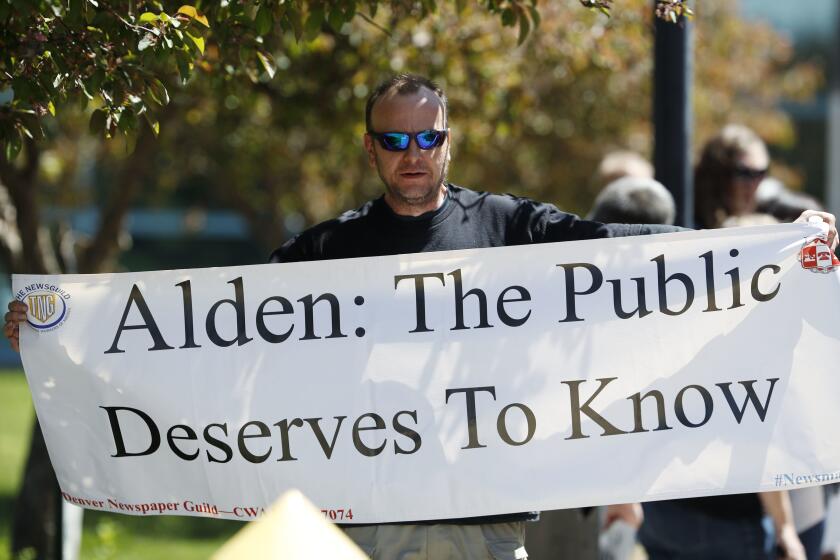Where be your gibes? Not online!
A RUMPLED Jason Alexander looks out from the video window, his signature sheepish grin beaming across the Internet. The former “Seinfeld” star is about to pitch a new series of shows, but these titles sound nothing like sitcom material.
The online video is the trailer for the upcoming season at Reprise Theatre Company, where Alexander is artistic director. The actor will star in the musical “I Love My Wife” as Alvin, a married New Jerseyite who is contemplating a foursome with another married couple.
“I’ll be semi-naked in it,” he says, directly addressing the viewer. “Don’t want to miss that.”
The video (in which Alexander keeps his clothes on) provides a sneak peek for another important launch -- a new video blog that Reprise plans to unveil this month. The blog will feature regular clips that give audiences a glimpse into the backstage process.
Like a growing number of theater companies, Reprise is embracing video blogging as a way to crash the fourth wall and communicate directly with audiences. But video blogging -- which is essentially blogging with a camera instead of a keyboard -- raises a number of thorny issues unique to the theater world. The biggest obstacle is Actors’ Equity Assn., which regulates the kind of videos that theater companies can post online.
The union’s guidelines vary from theater to theater and city to city. People in the industry say the rules are needlessly complicated and difficult to understand. In today’s shoot-and-upload culture, the Equity rule books can be a major nuisance and even a showstopper.
Most theaters must abide by the so-called three-minute rule: A video clip of a rehearsal or performance can’t exceed three minutes and can’t include a full scene or musical number. The rules were established in 1980 and were originally intended to regulate the kind of theater footage aired on television news shows. For the most part, those rules have remained unchanged for 28 years even as video blogging and other forms of multimedia have become the norm.
Originally, they were designed in part to prevent theaters from using footage of actors to sell tickets. That rationale is still in force today. Certain Equity contracts forbid companies from placing a ticket-purchase hyperlink on the same page as a video.
For theaters with limited marketing budgets, self-made video is a fast and inexpensive way to get their message out.
“The only thing it costs is time,” says Greg Reiner, managing director of the Actors’ Gang, based in Culver City. “Being a smaller theater, you can adapt and do things quickly.”
Video blogs are also important Web-traffic drivers, according to the Pasadena-based Furious Theatre Company. The theater monitors page views and e-mail subscribers, encouraging them to visit the blog. Google searches for “Furious Theatre” consistently list the company’s blog ahead of its official website -- an indicator that the blog site is the more popular of the two.
All of this makes the Equity rules concerning video seem painfully old-fashioned, according to theaters.
Reprise ran into difficulty last season when it attempted to film rehearsals of the Rodgers and Hart musical “On Your Toes.” According to the theater, its contract didn’t require the cast to be notified about taping. But Actors’ Equity claimed that cast approval was necessary. Eventually, the theater reached an agreement with the union and notified the actors.
“There’s this old-school mentality,” says Danny Feldman, managing director of Reprise. “I understand they want to protect the actors, and that’s good. But the rules were clearly written in a different era.”
Matters become more complicated when video blogs are archived. “They get harder for us to monitor,” says Dwane Upp, a Taping and Filming representative at Actors’ Equity. Upp says that if a theater wants to post multiple performance videos for a single production, the combined running time can’t exceed three minutes.
To stay within those guidelines -- and avoid fines -- Reprise’s video blog will consist largely of nonperformance footage, mostly interviews and backstage tours, which aren’t regulated by Equity.
Alexander says he wants the blog to maintain a candid and informal feel. “We use an iMac with the built-in camera,” explains the actor. “The less veneer-y it looks, the better. We want musical theater to reach out into the L.A. community like it hasn’t done before. And I think this is one way to achieve that.”
--
Tough on the little guys
IN L.A., the majority of theaters are 99-seat houses or smaller. An estimated 250 such companies operate in the metropolitan area, according to the LA Stage Alliance, a nonprofit organization that monitors the performing arts.
Unlike companies such as Reprise, 99-seat houses run under a different set of guidelines called an Equity Waiver code that makes it harder to video blog. Under the code, any performance video posted to the company’s website must be approved by Equity, no matter how long the clip is. The code, which varies among cities, also sets rules for production safety, onstage nudity, rest periods and many other technical issues.
“For a theater to be able to post a whole scene online would be powerful,” says Sean Cawelti, artistic director of Rogue Artists Ensemble, a Signal Hill-based company that specializes in puppetry and mask-based theater. “Large houses can negotiate a special arrangement with Equity, but small theaters are being told we can’t.”
Rogue Artists’ blog has shifted away from presenting performance videos and moved toward trailers and featurettes that don’t depict actors. “I believe there are good things that come from” Equity rules, Cawelti says. “However, it becomes a negative when it prohibits small arts organizations from marketing their products on the Internet.”
Some theaters have found ways to work comfortably within the Equity Waiver code.
For its recent revival of Paul Slabolepszy’s “Saturday Night at the Palace,” Furious Theatre installed a webcam at the back of the theater that was set to take a photo every two minutes. They ended up with a stop-motion video of the old set going down and the new set going up. The video avoids showing actors performing on stage.
“It’s a gray area considering what full Equity houses are doing,” says Doug Newell, a Furious ensemble member who shot the video. “For us, it’s not a great concern because of people’s attention spans. I think you lose people online after three minutes.”
--
Ready for a change
THE PRESSURE on Actors’ Equity to update its online video rules has mounted steadily during the past several years, especially as more theaters cross-post their videos on blogs, YouTube, MySpace or Facebook pages.
Change could be coming soon, however. The union is working on a revised contract that would modify the rules governing the uploading of video.
The content of the revision is still under wraps, but the union revealed that the new rules would only apply to large theater companies nationwide operating under Equity contracts, not the 99-seat houses. A decision is expected on the contract in September.
For small theaters nationwide, any discussion regarding new media is on hold, according to Actors’ Equity. One prickly issue is the disparity between small theaters in L.A. and in New York. The Equity code is stricter for New York theaters, prohibiting all taping of performances in 99-seat houses or smaller. “The environment in LA is much more film- and TV-driven, so this is a reason for the difference,” says Maria Somma, a spokesperson for Actors’ Equity.
Whatever the union ultimately decides to do -- and however long it takes to do it -- theater companies see little choice but to continue innovating online.
“We can’t afford to ever be behind the curve,” says Nick Cernoch, an ensemble member and marketing and administrative manager at the Furious Theatre. “Some audiences may potentially have a bad impression of theaters that don’t have a video presence because it’s second nature to them. It’s become a way of life for younger theater audiences.”
--
More to Read
The biggest entertainment stories
Get our big stories about Hollywood, film, television, music, arts, culture and more right in your inbox as soon as they publish.
You may occasionally receive promotional content from the Los Angeles Times.











